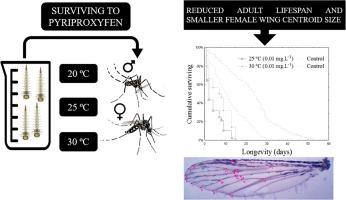Journal of Asia-Pacific Entomology ( IF 1.1 ) Pub Date : 2020-04-03 , DOI: 10.1016/j.aspen.2020.04.001 Lidia Moura , Barbara Lepretti de Nadai , Juliano J. Corbi

|
Aedes aegypti control in Brazil comprises integrated actions, in which larvicide application is a supplementary measure. Despite the importance of analyzing the effects of temperature on the efficiency of larvicides to control mosquito populations, there is still a lack of information regarding the sublethal effect of larvicides. We hypothesized that mosquitoes which survived pyriproxyfen exposure, during their immature development, have small body sizes and live less than mosquitoes that were not exposed to this larvicide. We investigated the sublethal effects of five different pyriproxyfen concentrations (0.0001; 0.001; 0.01; 0.1 and 1 mg.L−1), under three different temperatures (20, 25 and 30 °C). As we increased the larvicide concentration, less larvae survived and developed into adults. However, at 30 °C the survival was higher than at 25 °C and 20 °C comparing the concentrations of 0.001 mg.L−1 and 0.01 mg.L−1 (10% and 16% high, respectively). Mosquito survivors to pyriproxyfen exposure, in all thermal conditions, had shorter adult life spans than mosquitoes not exposed to pyriproxyfen during the larval stage. The females exposed at 30 °C showed smaller wings than females from experiments at 20 °C. These findings provide evidence that the biological parameters of the adult lifespan and wing centroid size are impaired due to larval exposure to pyriproxyfen, even at high temperatures. Reduced longevity and small wing size are fitness costs to survive this larvicide exposure. These findings provide support to assess resistance development to larvicides through future generations and contribute to the discussion on improving the rational application of larvicides.
中文翻译:

不能杀死它的东西并不总会使它变得更坚强:吡ip昔芬治疗中的高温会导致埃及伊蚊成虫的寿命降低,雌性变小
巴西伊蚊的控制包括综合行动,其中杀幼虫剂是一种补充措施。尽管分析温度对杀幼虫剂控制蚊子种群效率的影响很重要,但是仍然缺乏有关杀幼虫剂的亚致死作用的信息。我们假设,在未成熟杀虫剂中暴露于吡ip昔芬中的蚊子的体型较小,并且比未暴露于这种杀幼虫剂的蚊子的寿命短。我们研究了五种不同吡吡氧芬浓度(0.0001; 0.001; 0.01; 0.1和1 mg.L -1的亚致死作用),三种不同的温度(20、25和30°C)。随着我们增加杀幼虫剂的浓度,更少的幼虫存活并发展为成虫。但是,在30°C时,与0.001 mg.L -1和0.01 mg.L -1的浓度相比,存活率高于25°C和20°C。(分别为10%和16%高)。在所有热条件下暴露于吡ip昔芬的蚊子幸存者的成年寿命要比幼虫期未暴露于吡ip昔芬的蚊子短。在20°C的实验中,暴露于30°C的雌性的翅膀较小。这些发现提供了证据,即即使在高温下,由于幼虫暴露于吡ip昔芬也会损害成年寿命和机翼质心大小的生物学参数。寿命的延长和机翼尺寸的减小是适应这种杀幼虫剂暴露的健身成本。这些发现为评估后代对杀幼虫剂的耐药性发展提供了支持,并有助于讨论如何改善杀幼虫剂的合理应用。











































 京公网安备 11010802027423号
京公网安备 11010802027423号